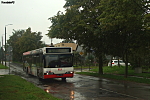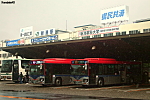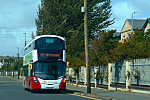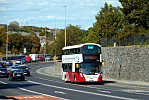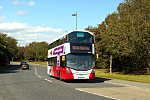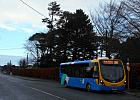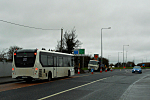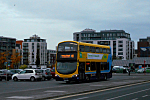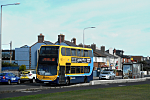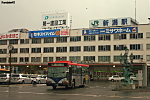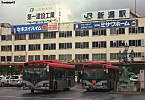Not logged in | Log in | Sign Up

Search Photos
Isuzu PKG-LV234L2 Erga Non-Step #5221
13 december 2018 - Shiki (Saitama Pref.), Honchō 5-chōme (埼玉県志木市本町5丁目), Prefectural Route 244. Now that I mentioned it, Saitama 244 is probably one of the shortest numbered roads in Japan, at only 855 metres.志05 (shi-05): 志木駅東口 (Shiki Station East Exit) → 宗岡 (Muneoka) → 志木駅東口 (Shiki Station East Exit) (circular route)
5221 is finishing its lap on the circular route 志05. The route connects Shiki Station with the low-density residential areas of Muneoka in northern half of the city, close to Arakawa and just short of the border with Saitama city. The route operates as a circular around the core of these residential areas, both clockwise and anti-clockwise. Amusingly enough, for Japan`s love of splitting out variations as separate route numbers, the two directions carry the same route number - it`s only trips cut short that have off-shoots.


Author: TranslatorPS 

Comments: 2
Isuzu QPG-LV234L3 Erga Non-Step #5457
8 october 2018 - Tōkyō, Toshima-ku, Ikebukuro 2-chōme (東京都豊島区池袋2丁目), Metropolitan Route 441.池21 (ike-21): 高島平駅 (Takashimadaira Station) → 池袋駅西口 (Ikebukuro Station West Exit)
This 池21 trip, operated by Ikebukuro depot this time, is nearing its end - after this stop, which doesn`t even have a timetable on Google Maps, all that is left is the Ikebukuro terminus. The advert carried is for a popular brand of green tea sold in plastic bottles and available in the vast majority of vending machines (and by extension, of shops). Despite the high number of buses passing through here, photography is made difficult by cars parking almost anywhere and the omnipresent little barriers.


Isuzu KL-LV280L1 Erga Non-Step #5023
16 october 2018 - Tōkyō, Toshima-ku, Nishi-ikebukuro 1-chōme (東京都豊島区西池袋1丁目), Ikebukuro-eki Nishi-guchi bus terminal main section. This terminal is dominated by Kokusai Kōgyō and its frequent connections. The following routes start here after all: 池02, 池03, 池04, 池05, 池11, 池20, 池20-2, 池21, and 池80 which runs to the depot (池 = ike). Route 池07 also appears here for its intermediate stop. All of the routes mentioned are operated by the nearby Ikebukuro depot, although 池20 and 池21 are operated jointly with Shimura depot, and the 池11 with Kantō Bus. Not all routes actually start service from stops in or near this shot, but due to the road and stop layout all of them at least turn around through here. Aside from typically city routes, there are also departures of the night bus parodies and the express airport buses from here. The latter is more so curious as one can get from Ikebukuro by rail to both key Tōkyō airports with one transfer at most (for Haneda via Yamanote and Keikyū lines transferring at Shinagawa; for Narita via Yamanote and Keisei lines transferring at Nippori), and even without transfers to Narita... and it would definitely be faster than by road, but nevertheless there is...was interest.

Comments: 4
Isuzu KL-LV280L1 Erga Non-Step #5037
16 october 2018 - Tōkyō, Toshima-ku, Nishi-ikebukuro 1-chōme (東京都豊島区西池袋1丁目), Ikebukuro-eki Nishi-guchi bus terminal main section.池21 (ike-21): 池袋駅西口 (Ikebukuro Station West Exit) → 高島平駅 (Takashimadaira Station)
Now that we are outside of the Yamanote line loop (and outside the Akabane, or rather Saikyō line axis), the number of buses operated by the metropolitan government drops a lot, even though there is still over 8 km left until the border of the 23 wards. Instead, bus transport in this area is dominated by an array of private companies, oftentimes associated with the private railway operators which have their lines or terminals nearby. Kokusai Kōgyō is an exception here - the company is not associated with any railway, despite a brief stint with Dai-tōkyū in the 1940s, as historically it was formed from mergers and splits of various private carriers in the Itabashi and Akabane areas. The operator currently has 10 garages spread around Tōkyō and Saitama prefecture. However logical it may be that the company spread out towards Saitama city (more or less along the already mentioned Saikyō line), its Hannō depot, detached from everything else, is quite curious (albeit historically justified), being in a typically Seibu area and what not.


Isuzu 2DG-LV290N2 Erga Non-Step #P-D302
25 december 2018 - Tōkyō, Bunkyō-ku, Ōtsuka 2-chōme (東京都文京区大塚2丁目), National Route 254.都02 (to-02): 錦糸町駅前 (Kinshichō Station) → 大塚駅前 (Ōtsuka Station)
Today`s topic is a short series of Toei buses. I think it would be worthwhile to explain what Toei actually is. It is in fact a section (bureau) of the metropolitan government of Tōkyō. To lay it over British terms, it`s as if the Greater London Assembly planned and operated the bus services directly using its own buses and hiring its own drivers (not even with TfL, but literally as an office out of the GLA). When referring to the Tōkyō metropolis it`s important to note that I`m referring to the prefectural-level body - Tōkyō city as a local government body ceased to exist in 1943. Perhaps it`s a slightly strange arrangement, but Japan just about doesn`t have tendering and contracting processes in public transport (at least as far as I know) - it`s either one of the 28 local government transport bureaus, or private operators, which are one way or another often tied to one of the railway conglomerates.


Isuzu QDG-LV290N1 Erga Non-Step #R-B771
14 september 2018 - Tōkyō, Edogawa-ku, Naka-kasai 5-chōme (東京都江戸川区中葛西5丁目), bus terminus adjacent to Kasai metro station.秋26 (aki-26): 葛西駅前 (Kasai Station) → 秋葉原駅前 (Akihabara Station)
Apparently you can get to Akihabara on this bus. So far, true, but whether this thing`s got a set frequency is another story. Mondays to Fridays it sports a solid morning peak at every 6-10 minutes, interpeak at every 26-28, and an afternoon peak at every 19-21, or maybe 15-16. On Saturdays it runs apparently every 19-21 minutes in the morning, but later every 23-24. Only on Sundays does it run every 20 minutes for most of the day. What of it, however, if the last departures are before 10pm? That`s how most more frequent city bus routes look like in Japan: most companies don`t know what a set frequency is, never mind synchronisation modules, and above all, departures after 22:30 are rare beyond rare.


Nissan Diesel PKG-RA274KAN / NSK 96MC #N-P482
12 september 2018 - Tōkyō, Toshima-ku, Higashi-ikebukuro 1-chōme (東京都豊島区東池袋1丁目), Metropolitan Route 305, Ikebukuro-eki Higashi-guchi bus stop.王40甲 (ō-40-kō): 西新井駅前 (Nishi-arai Station) → 池袋駅東口 (Ikebukuro Station East Exit)
One of the first photos that I took in Japan that can be published here. It`d been only a week and a bit by then - I still didn`t really know what, how, where and when...


Neoplan N4020 #819
26 august 2018 - Radom, Dzierzków, ul. Odrodzenia. Myślę, a wrzucę Neoplana na 60. zdjęcie (w końcu od następnego zdjęcia druga strona na liście zdjęć w profilu), znajduję kandydata, a ten nie miał od ośmiu lat żadnego zdjęcia tutaj.O AirShow 2018 nie ma co się przesadnie wypowiadać - pogoda zrujnowała temat w obydwa dni, a że drogi w rejonie lotniska są jakie są, to nawet chodzić i zdjęcia robić było trochę szkoda, przynajmniej jeśli się miało choć odrobinę szacunku wobec obuwia... Linia 14 na swoim klasycznym objeździe na pokazy, czyli kryterium uliczne przez Słowackiego, al. Wojska Polskiego, Odrodzenia i powrót na stałą trasę, bez obsługi Dzierzkowa ani Sadkowa. Kryterium to czyni z czternastki, jak i z wielu innych linii, de facto linię okrężną z jednym końcowym.

Author: TranslatorPS 

Comments: 2
Isuzu 2PG-LV290Q2 Erga Non-Step #H1127-I
30 december 2018 - Niigata (Niigata Pref.), Chūō-ku, Hanazono 1-chōme, bus station located in front of Niigata railway station (新潟県新潟市中央区花園1丁目).C31: 新潟駅前 (Niigata Station) → 西部営業所 (Seibu Depot)
Back to Niigata we go... Two Ergas (titular and H1047-I on rte W22) and another I-have-no-idea-what-it-is are loading passengers at the stands of Niigata-eki-mae bus stop. As seen in the photo, the buses are reversed into the stand entrances, which is good in terms of pulling out from the station, as well as given that passengers board via the back doors.
The bus network is built such that routes that operate mostly within the city terminate here. However, routes that operate outside of the built-up areas but still operated with city buses serve this stop en-route. Since they serve these reverse-entry stands, buses arriving here reverse in service with passengers on-board. However, staff on-site assist with the reversing process; they are also the ones to permit pax to enter the stand area. I don`t have any photos worth publishing from the reversing itself, however. The snow comes as a bonus.


Author: TranslatorPS 

Comments: 1
Wright StreetLite Max DF #12133
29 january 2020 - Dublin, Dublin City University campus.104, diagram 5241: Clontarf Station → DCU Helix This university is served by a rather rich network of bus connections. Routes 44, 104 and 220/A terminate within the campus, each of them running roughly every hour. The latter only came here in January 2019 when it was taken over by the company in photo (all 220 arrivals change into 104s and vice versa). Furthermore, routes 31D, 42D, and 70D also terminate here - each does one pair of term-time only Monday-Friday rush-hour departures. Walking out to Collins Avenue Extension outside to the left we get hourly departures on the 24-hour regional route 109A (DCU is served by daytime departures only, however). On top of that, a pair of Monday-Friday rush-hour rte 126 trips terminates there (well, the morning arrival is rte 126D, the evening departure is a plain 126). Walking a bit to the west gate we arrive at Ballymun Road, whish is served by the afore-mentioned 70D, but also by the all-day routes 4, 9, 11, 13, and 155, each of them operating at a frequency between 12 and 30 minutes midday. If you want to or need to take a walk, about 400-500 metres to the east we have Swords Road with routes 1, 16, 33, and 41/C, as well as the regional rte 101. Except for the 33, all city routes run between every 12 and 20 minutes midday.
The main reason why I`m mentioning this is that with todays results publication, my four-year study at DCU is now finished.


Author: TranslatorPS 

Place: Dublin / Baile Átha Cliath (Dublin / Áth Cliath)
| Owner: Go-Ahead Ireland Dublin / Baile Átha Cliath | Transport Authority: Transport for Ireland | Route: 104
Volvo B5TL / Wright Eclipse Gemini 3 #VWD431
21 june 2020 - Galway, Costello Road.402: Seacrest → Merlin Park Hospital
And the lost sheep has been found - VWD431 was the last of the 429-432 batch to enter revenue service. This batch was delayed maybe by even a year, but was finally delivered to Galway in May.


Author: TranslatorPS 

Place: Galway / Gaillimh (Galway / Gaillimh)
| Owner: Bus Éireann Dublin / Baile Átha Cliath | Transport Authority: Transport for Ireland | Route: 402
Comments: 1
Isuzu QQG-LV234L3 Erga Hybrid Non-Step #E165
14 september 2018 - Tōkyō, Edogawa-ku, Naka-kasai 5-chōme (東京都江戸川区中葛西5丁目), bus terminal adjacent to Kasai metro station. I wasn`t in Japan for even two weeks at that point, but I made use of the still free days, and I went to the annoyingly located Tokyo Metro museum. I recommend it by all means - for an acceptably priced ticket of 200 yen (approx. €1.50) one can (try to) learn the history of Tokyo`s subways, their methods of construction, methods of power, or make attempts at a number of simulators.Keisei Bus operates a wide network of bus services to the east of Tōkyō, reaching as far as Chiba. In the Tōkyō area itself they`re biting into Toei and Tōbu areas.


Author: TranslatorPS 

Mitsubishi Fuso QKG-MP37FMF Aero Star #1352
19 february 2019 - Nagoya (Aichi Pref.), Naka-ku, Sannomaru 3-chōme (愛知県名古屋市中区三の丸3丁目), Prefectural Route 215. Oh the irony, I caught a private operator right in front of the city hall that houses the municipal operator! The world`s ending...There are seven possible routes that the bus in photo may be operating - numbered from 30 to 36. I have absolutely no idea which one however, as the scrolls are showing something completely different (all seven routes share the same route from the closest located terminus, so that`s probably why), but I put in 30 based on the current schedule. Such passenger information of course goes against logical practice, but as I just mentioned, the operator can afford to do so if the variations operate a common route, especially given that it`s the only service they operate in this spot.


Author: TranslatorPS 

Hino PKG-KV234N2 Blue Ribbon II Non-Step #NH-259
19 february 2019 - Nagoya (Aichi Pref.), Naka-ku, Sakae 3-chōme (愛知県名古屋市中区栄3丁目), one of the multiple parts of the bus terminal adjacent to Sakae metro station. On the second day of my stay in Nagoya, the weather went downhill altogether - it was the only day so bad during my 10 days of wandering halway across the country. Nagoya`s city buses use the typical route numbering scheme, that is, a kanji character and some number. Noticeably however, Nagoya is not afraid to use two characters (see NH-264 to the right on rte 高速1 or my previous photo of NH-144), which is for example rather rare in Tokyo if it`s not the Latin alphabet. I only used the buses a few sparse times, using the subway more to move around the city. The municipal operator has a flat fare, and thus passengers board at the front.

Author: TranslatorPS 

Comments: 10
Hino QPG-KV234N3 Blue Ribbon II Non-Step #1365
19 february 2020 - Nisshin (Aichi Pref.), Akaike 1-chōme (愛知県日進市赤池1丁目), near Akaike station. Akaike is a through-operations border station - Nagoya Subway Tsurumai Line ends here, and Meitetsu Toyota Line starts here, and mutual through-operations take place here. Not too far are the Nisshin metro depot and Nagoya City Tram and Subway Museum. In the background, 1386 on rte either 46 or 47.In contrast with the previous shot from the city hall, here I was able to at least deduce the route number from the digitless scroll. Routes 51 and 53 form an alternative route to Meitetsu Toyota Line between Akaike Station here and Toyota city centre. And yes, it`s the same Toyota City where the car manufacturer by the same name is headquartered. The conglomerate`s name was not a result of the city name by any means however - quite the opposite, it was Koromo-shi in 1959 that took on the name of the manufacturer that was established in 1937.
This photo is the last from the core of my 10-day trip across half of Japan that took place in February 2019. Any further photos from the Land of the Rising Sun will be perhaps filling in gaps from this trip, or photos from areas closer to my then-home around Tōkyō.


Author: TranslatorPS 

Hino PJ-KV234N1 Blue Ribbon II None-Step #NH-144
18 february 2019 - Nagoya (Aichi Pref.), Nishi-ku, Nagono 2-chōme (愛知県名古屋市西区那古野2丁目). Some 16 months after the trip itself I finally got around to photos from Nagoya. I don`t have anything from the subway, considering that the network itself is not really good for photography. To start off a few shots of the municipal operator - much like in Tōkyō, Nagoya has a Transport Bureau attached to the city hall. Worth nothing is that there are 26 local administration units with such a Transport Bureau, most often called kōtsu-kyoku like here.

Author: TranslatorPS 

Volvo B5TL / Wright Eclipse Gemini 3 #VWD430
27 may 2020 - Galway, Bishop O`Donnell Road, R338.405: Ballybane Ind. Estate → Rahoon
Slightly behind schedule, this somewhat new bus is climbing its last kilometre. VWD430 entered revenue service only in the past month, which is curious because BÉ had already long ago put VWD460 and VWD461, buses several months newer than this, into revenue service.
It looks like the Saturday Plus schedules will soon be gone, however. Rumours have started that regular Monday-Friday schedules will be back from 8 June. Given that the restrictions that were put in place to slow down the coronavirus spreading are being loosened up, it was expectable. One thing that remains to be seen, however, is whether Bus Éireann will return to its full service on their commercial long-distance "Expressway" routes. A few weeks ago they were forced to introduce reduced schedules after it turned out that their cash reserves are ending, and keeping a full Expressway schedule supposedly cost them up to €750,000 a week...
This photo was taken during exercise and well within the 5 km radius from my current residence.


Author: TranslatorPS 

Place: Galway / Gaillimh (Galway / Gaillimh)
| Owner: Bus Éireann Dublin / Baile Átha Cliath | Transport Authority: Transport for Ireland | Route: 405
Volvo B5TL / Wright Eclipse Gemini 3 #VWD413
27 may 2020 - Galway, Gateway Retail Park access road.405: Rahoon → Ballybane Ind. Estate
The bus just departed the western terminus of the cross-city rte 405. Including a scheduled 5-minute layover at the central transfer stop, the trip is scheduled to take 38 minutes.
In terms of Irish transport, the novel coronavirus left its mark quite visibly. Mostly as a result of quite strict civilian movement restrictions (the initial restriction was to not go further than a 2 km radius from their residence if not for work, shopping or medical needs; currently the cap is set at 5 km), most private companies that run commercial services suspended them until further notice. Public Service Obligation routes - that is, routes contracted with the NTA - saw so-called "Saturday Plus" schedules introduced Monday-Friday from 1 April. They are simply Saturday schedules with extra trips in the mornings where the Saturday schedule started noticeably late, and keeping those routes that don`t run on Saturdays running. However, the companies that are taking the biggest blows are those whose existence relies on school services and tourism-oriented hires.
This photo was taken during exercise and well within the 5 km radius from my current residence.


Author: TranslatorPS 

Place: Galway / Gaillimh (Galway / Gaillimh)
| Owner: Bus Éireann Dublin / Baile Átha Cliath | Transport Authority: Transport for Ireland | Route: 405
Hino PDG-KR234J2 Rainbow II Non-Step #39-1305
17 february 2019 - Ōsaka, Kita-ku, Umeda 3-chōme (大阪府大阪市北区梅田3丁目). Since a comment from @empi asked for a Hino Rainbow in front of the rainbow, I will not fail to deliver! I was afraid the photo wouldn`t be good enough for publication, but I managed something out of it - even though it wouldn`t hurt if it was a bit more focused.To the left, JR West`s 641-15930 (なにわ200か19-85), a 2015 Isuzu Gala.


Author: TranslatorPS 

Hino PDG-KR234J2 Rainbow II Non-Step #39-1305
17 february 2019 - Ōsaka, Kita-ku, Umeda 3-chōme (大阪府大阪市北区梅田3丁目), Ōsakaeki-mae (大阪駅前) bus terminal. Once again it`s 39-1305, but simply because it`s the best seen bus here. One of the indispensable elements of Japanese bus networks is these small bus terminals located at railway stations. In this case 21 different routes depart from here. Aside from the titular bus we also have: to the left on rte 97 20-2866, a 2010 Isuzu Erga, to the right on rte 36 36-0806, a 2006 Hino Blue Ribbon II, and in the background on rte either 8 or 53 39-1307, a 2009 Hino Rainbow II. One will notice that they are barely any different from each other - after all, Hino Rainbow is merely a rebranded Isuzu Erga. To finish off, above all of them is an eight-car JR West 323 series set.

Author: TranslatorPS 

Hino PJ-KV234L1 Blue Ribbon II Non-Step #36-0803
17 february 2019 - Ōsaka, Kita-ku, Umeda 3-chōme (大阪府大阪市北区梅田3丁目), right beside Ōsaka (JR) and Umeda (back then still, currently Ōsaka-Umeda - private railways) railway stations. The topic of Latinization of public transport information in Japan is as broad as the archipelago itself. In the Tōkyō area it`s pretty much an obligatory element on the vehicles, and it`s quite similar in Kyōto. Other areas of the country are quite varying. The scrolls here are likely to remember the bus` introduction into service in 2006, so I`m not overly surprised by the lack of Latin transciption (Itakano-shako, or Itakano Depot, for those curious). However, one should expect even less Latin transcriptions at bus stops, but even that will depend on the area and the company.

Author: TranslatorPS 

Comments: 3
Isuzu PDG-LV234L2 Erga Non-Step #20-2859
16 february 2019 - Ōsaka, Kita-ku, Ōfukachō (大阪府大阪市北区大深町), National Route 176. I spent the most time in Ōsaka during my ten-night long journey - a whole three nights. It was also the only city that I reached without using any Shinkansens - I decided that the conventional railway offer was more than satisfactory for just fraction of the price.I`m not entirely sure what is happening with the city buses in Ōsaka. The city department finished their operations on 31 March 2018 and since then the entire network has been operated by a supposedly private, but not really private company. Its shareholders are Ōsaka City and Ōsaka Metro Co., Ltd., or rather, also Ōsaka City.
Completely unrelated, but route 34 seen in the photo was 214.5 mln yen in the black in year 2006 (about 1.83 mln euro by today`s exchange rates), and so it was on top of the rankings in the back then municipal operator`s records.


Author: TranslatorPS 

Comments: 2
Hino LKG-KV234N3 Blue Ribbon II Non-Step #奈良200か724
16 february 2019 - Nara (Nara Pref.), Kasuganochō (奈良県奈良市春日野町), or something like that. Nara is known for its deer walking around the area surrounding the temples, which happily accept special wafers from tourists` hands, however risky it may be for sometimes they try to eat the entire tourist (ekhm). As for the bus, I have completely no idea what it`s meant to be running as (there are some 11 routes operating along that street). It definitely won`t be one of the mutually countered circular routes 1 and 2 that operate around Nara`s city centre.

Hino PB-HR7JHA Rainbow HR #29573
15 february 2019 - Himeji (Hyōgo Pref.), Ekimaechō, Ōtemae-dōri extension (兵庫県姫路市駅前町).13: 姫路駅北口 (Himeji Station North Exit) → 田寺北口 (Tadera North Entrance)
As far as I noted, Shinki Bus is the main bus service provider in Himeji. Its network of over 50 routes is concentranted on the main Himeji railway station. The network is accessible insofar that route numbers don`t contain kanji characters - however, to counterbalance, the company employs a particularly strange fleet number system. For example here, the combination of the first digit (2) and the bus being a Hino means that the 95 in the middle stands for a bus... produced in 2005.


Author: TranslatorPS 

Hino KL-HU2PMEE Blue Ribbon City Non-Step #6672
15 february 2019 - Himeji (Hyōgo Pref.), Honmachi, Otemae-dōri (兵庫県姫路市本町大手前通り). In the background we have the world-famous Himeji Castle (姫路城). Built between 1333 and 1346, it has been associated with the Japanese government since 1580, and on the UNESCO World Heritage index since 1993. It`s located bang on in the city centre - a mere 15 minute walk from the main railway station. The highest-located spaces offer an excellent panorama view of the city. As for the photo itself, what else could have arrived than an out of service bus...

Isuzu 2PG-LV290N2 Erga Non-Step #A8-726
16 may 2019 - Niiza (Saitama Pref.), Higashi 2-chōme (埼玉県新座市東2丁目), Prefectural Route 40, at around Rikkyō-mae stop.清61 (kiyo-61): 志木駅南口 (Shiki Station South Exit) → 清瀬駅北口 (Kiyose Station North Exit)
This photo may seem random, but it`s mostly for the sake of trivia. For the first time in 67 years, Seibu Bus is changing its route bus livery. You can see the new template at these URLs: sides, front and back. I dare say it`s nothing more than the sprayman`s nightmare, but I imagine they have already come up with a solution for that. The paintjob needs the refreshment (the current template is showing its age), and you can also see the grey and blue which have recently dominated the mother company`s rail stock.


Author: TranslatorPS 

Isuzu QKG-LV234L3 Erga Non-Step #広島200か17-78
14 february 2019 - Hiroshima (Hiroshima Pref.), Naka-ku, Hashimotochō (広島県広島市中区橋本町). I did not delve deep into the bus network details during my stay in Hiroshima, mostly because I was focusing on the tramway network instead. I did note three main bus operators, however. One positive point for Hiroshima is a somewhat more normal bus route numbering system, without kanji characters.

Author: TranslatorPS 

Place: 広島市 [Hiroshima-shi] (Hiroshima-ken)
| Owner: GeiyoBus 東広島市 [Higashihiroshima-shi] | Route: 40-1
Hino KL-UA452MAN / NSK 96MC #206
14 february 2019 - Hiroshima (Hiroshima Pref.), Naka-ku, Hachōbori (広島県広島市中区八丁堀). The line-up for the lights offers a small cross-section of cars used in Japan. Meanwhile, rte 25 is the most convenient connection between Hiroshima station and the Peace Memorial Park area, at least in terms of walking distances as the stops are located just in front of the park.

Author: TranslatorPS 

Volvo B5TL / Wright Eclipse Gemini 2 #SG115
23 january 2020 - Enniskerry, R760 (village square).44, diagram 2-44: DCU Helix → Enniskerry
At its simplest, route 44 needs four buses to operate an hourly frequency. However it`s scheduled together with the peak time only route 44B, so overall it needs five buses and 12 drivers. The route is somewhat demanding in the southern portions of the city, but even without those it`s not the simpliest road in the city at all.


Author: TranslatorPS 

Place: Enniskerry / Áth na Sceire (Wicklow / Cill Mhantáin)
| Owner: Dublin Bus Dublin / Baile Átha Cliath | Transport Authority: Transport for Ireland | Route: 44
Volvo B9TL / Wright Eclipse Gemini #11904
23 january 2020 - Enniskerry, Glencree Road.185, diagram 4291: Enniskerry Shop River → Bray Station
Crap weather and so the background is crap too. Rte 185 is supposed to be operated by single deckers (double deckers appear on selected journeys only and this isn`t one of them). However, a short chat with the driver later and it turns out there wasn`t anything spare in the depot - board 4291 pulls out at 11:50. The long-term lack of double-deckers on a more regular basis on the 185 shows however, with tree branches encroaching into the road already.


Author: TranslatorPS 

Place: Enniskerry / Áth na Sceire (Wicklow / Cill Mhantáin)
| Owner: Go-Ahead Ireland Dublin / Baile Átha Cliath | Transport Authority: Transport for Ireland | Route: 185
Wright StreetLite Max DF #12119
23 january 2020 - Enniskerry, Main Street.185, diagram 4271: Enniskerry Shop River → Bray Station
And as I have mentioned, single deckers are the norm. On the other hand however, single deckers are about 1.5 metres longer than double deckers, and thus they`re not the most favourite in the drivers` eyes on tighter routes (and mind you, rte 185 is one of those).


Author: TranslatorPS 

Place: Enniskerry / Áth na Sceire (Wicklow / Cill Mhantáin)
| Owner: Go-Ahead Ireland Dublin / Baile Átha Cliath | Transport Authority: Transport for Ireland | Route: 185
Wright StreetLite Max DF #12115
14 january 2020 - Newtownmountkennedy, R772.184, diagram 4251: Bray Station → Newtownmountkennedy (Newcastle Hospital)
Route 184 terminates here, by the Newcastle Hospital. With the transfer of the route to GAI the service level was improved - going up from a 30-min frequency Mon-Fri, 60-min Saturdays, and 120-min Sundays straight up to every 30 minutes every day. Thus rte 184 became a much more worthwhile option when it comes to getting to the closest towns (Greystones and Bray as seen on the scroll) and the nearest train stations. Bus Éireann also operates rte 133 through here, but how important is it aside from a direct access to Dublin city centre and airport... I have no idea.


Author: TranslatorPS 

Place: Newtownmountkennedy / Baile an Chinnéidigh (Wicklow / Cill Mhantáin)
| Owner: Go-Ahead Ireland Dublin / Baile Átha Cliath | Transport Authority: Transport for Ireland | Route: 184
Wright StreetLite Max DF #12123
15 january 2020 - Dublin, car park near Clontarf Road station.104, diagram 5231: DCU Helix → Clontarf Station
With route 104 being taken over by Go-Ahead Ireland the terminus in Clontarf moved. Instead of terminating at the Clontarf bus garage, some 2.5 km to the east from here, it now terminates by this DART station. It offers some transport integration - you can see the station building to the left of the photo, the DART runs every 10 minutes Monday to Friday, and you just have to fit in well with the 104 that runs every hour. The card with 5231 seen in the front window is the bus running number (or `board number` as referred to in Dublin Bus), which is not related to the route number, in comparison to Dublin Bus practice.


Author: TranslatorPS 

Place: Dublin / Baile Átha Cliath (Dublin / Áth Cliath)
| Owner: Go-Ahead Ireland Dublin / Baile Átha Cliath | Transport Authority: Transport for Ireland | Route: 104
Alexander Dennis Enviro 200 MMC 10.8m #2703
7 january 2020 - Ashbourne, R135. Go-Ahead currently has three Public Service Obligation contracts signed with the NTA. The first of these, for the operation of city services in Dublin, commenced operations on 9 September 2018 and was introduced phase-by-phase all the way until 24 March 2019. Although signed second, the third to commence was the Kildare commuter routes contract, where operations started on 1 December 2019 (with the second and last phase set to start on 19 January 2019). The last contract is this small one for rte 197, which began on 24 November 2019. Rte 197 is a local linking route operating between two towns to the north of Dublin along roads which made me question whether having a bus run there isn`t too much. The operator purchased three of the buses as seen above, but on top of that, two of the 40 Streetlites from the city services contract have been adapted as operational spares.

Author: TranslatorPS 

Place: Ashbourne / Cill Dhéagláin (Meath / An Mhí)
| Owner: Go-Ahead Ireland Dublin / Baile Átha Cliath | Transport Authority: Transport for Ireland | Route: 197
Wright StreetLite Max DF #12138
7 january 2020 - Dublin, Malahide Road and Kilmore Road junction.104, diagram 5241: Clontarf Station → DCU Helix
Almost all PSO service buses since 2012 have been bought by the state transport authority. This holds true for this bus as well - as part of its Dublin city services contract, Go-Ahead Ireland received 40 of these buses from the NTA. Current schedules require 33 of these buses Monday-Friday, and they are used on routes 33A, 33B, 104, 111, 161, 184, 185, 220/A, 238, 239, and 270. They used to operate rte 102 as well, but have since disappeared from there in favour of double-deckers.


Author: TranslatorPS 

Place: Dublin / Baile Átha Cliath (Dublin / Áth Cliath)
| Owner: Go-Ahead Ireland Dublin / Baile Átha Cliath | Transport Authority: Transport for Ireland | Route: 104
Volvo B5TL / Wright Eclipse Gemini 2 #SG541
24 october 2019 - Dublin, Tallaght, The Square. A few years after the mass purchases of ALX400 bodywork buses (there were 659 bought in total, 649 on Volvo and 10 on Dennis chassis), Dublin mass-ordered Volvo B5TLs with Wright Eclipse Gemini 2 bodywork (oh wait, that`s actually Gemini 3 with a Gemini 2 face). The final number is 621 buses for Dublin Bus (including the 49 units transferred to Go-Ahead), and at least 36 more for Go-Ahead. As a result there are at least 657 units to be seen around Dublin, all from 2012-2020 production, easily matching the previous bulk from the years 2000-2006.

Author: TranslatorPS 

Place: Dublin / Baile Átha Cliath (Dublin / Áth Cliath)
| Owner: Dublin Bus Dublin / Baile Átha Cliath | Transport Authority: Transport for Ireland | Route: 49
Volvo B9TL / Alexander Dennis Enviro 400 #EV 13
14 september 2019 - Dublin, Clontarf Road. There you go, a single-doored piece of cardboard-quality construction. Rte 130, operated by the Clontarf depot, for the longest time has been home to the oldest buses in the garage. After the last Clontarf AVs were withdrawn in 2018, it`s now this type of Alexander "scrap".

Author: TranslatorPS 

Place: Dublin / Baile Átha Cliath (Dublin / Áth Cliath)
| Owner: Dublin Bus Dublin / Baile Átha Cliath | Transport Authority: Transport for Ireland | Route: 130
Eidan 7000 #7110
4 july 2019 - Kawagoe (Saitama Pref.), Tōbu Railway Kawagoeshi station (埼玉県川越市・川越市駅).Yūrakuchō/Fukutoshin/Tōyoko Line diagram 93S: C2193S/A1293S, Kawagoeshi 12:40 → Shin-kiba 14:03 Speaking of the Yūrakuchō line - despite the 10-car formation, for the first seven stations it will be under one-man operation. The section from Wakōshi to Kotake-mukaihara has been in complete one-man operation since 28 March 2015. Conductors only get on in Kotake-mukaihara. Hence there is no longer a conductors` office in Wakōshi - only the drivers` office remains, since the conductors` office was moved to Kotake-mukaihara, where it is alongside the Fukutoshin line drivers` office.


Comments: 1
Alna Sharyo 3950 #3955
14 february 2019 - Hiroshima (Hiroshima Pref.), Minami-ku, Matobachō 1-chōme (広島県広島市南区的場町1丁目). On the other hand, articulated cars (which only run on two routes: 1, and the quasi-railway 2) are crew-operated. The conductor is located by the last door, and they handle the doors and help with payment. Regardless, doors for boarding and alighting are still set (enter by the middle doors, leave by the doors by the cabs). Furthermore, crew-operated trams stop at all stops regardless, whereas one-man cars only on request.

Author: TranslatorPS 

Alna Sharyo 801 #814
14 february 2019 - Hiroshima (Hiroshima Pref.), Naka-ku, Hashimotochō (広島県広島市中区橋本町). The Hiroshima tram network is 35 km long (therein 18.9 km operate under the Tramway Act, and 16.1 km under the Railway Business Act). There are seven lines in terms of infrastructure, and eight service routes (numbered from 1 to 9 without a rte 4). Miyajima Line (the sole Railway Business Act line) is operated solely by rte 2 (served with articulated cars), which is also the longest route in terms of journey time. Worth noting is the relatively uncommon in Japan standard 1435 mm track gauge. Single cars are all one-man operated.

Author: TranslatorPS 

Alna Sharyo 801 #814
14 february 2019 - Hiroshima (Hiroshima Pref.), Minami-ku, Kōjin Bridge (広島県広島市南区荒神橋). There are of course short articulated cars as well (as you can see on rte 5 in the back), but these are one-man operated - given they have just two sets of doors. Payment as per usual in Japan - upon alighting, and as per usual one can pay in cash or the whole plethora of IC cards. There are also day tickets available, where the passenger scratches off the validity date and just shows it to the driver.

Author: TranslatorPS 

Osaka Sharyo 2601 #912
13 february 2019 - Hiroshima (Hiroshima Pref.), Naka-ku, Ebanishi 1-chōme (広島県広島市中区江波西1丁目). After two nights in Nagasaki I arrived in Hiroshima, taking four hours on the limited express by JR Kyūshu and on the shinkansen by JR West combined.Perhaps I was just somehow mentally ready for it, but Hiroshima`s atomic bomb museum did not turn down my mood as much as the Nagasaki one did. Nevertheless, the still-standing memorial-ruin of the old Hiroshima Prefecutre Industrial Promotion Hall continues to remind of what took place nearly 75 years ago.
Worth noting that the previous photo of this car also found it on rte 8. I would not be surprised if it was marked in for the 8+7 interworked services (cars work in an Eba -8- Yokogawa -7- Hiroden-honsha-mae -7- Yokogawa -8- Eba pattern).


Author: TranslatorPS 

Isuzu KC-LV380N Cubic #1714
11 february 2019 - Nagasaki (Nagasaki Pref.), Shinchimachi (長崎県長崎市新地町).I would like to wish everyone a positive and successful New Year!
I originally intended to upload this nearly a year ago, but my spring semester didn`t agree with that idea, so I`m only getting to it now... yet the photo`s been laying around ready for all that time. The scroll is showing perahps the most popular destination in Japan - 回送 (kaisō) being any sort of deadhead/empty journey. There`s plenty of those to be seen around in Japan due to a lot of duties (from what I`ve seen) having to finish or start in the garage. And there you go, empty mileage left, right, and centre.


Author: TranslatorPS 

Place: 長崎市 [Nagasaki-shi] (Nagasaki-ken)
| Owner: Nagasaki Bus 長崎市 [Nagasaki-shi]
Isuzu QPG-LV234N3 Erga Non-Step #1584
11 february 2019 - Nagasaki (Nagasaki Pref.), Dejimamachi (長崎県長崎市出島町). A Japanese city bus operator without an Isuzu Erga? I probably mentioned it, but it`s like a British operator without an ADL.Nagasaki city buses irritated me with their lack of Latin transcription on the scrolls - something I`d only seen in Kōbe other than here. On top of that, the timetables on stops were done in the "one table for all routes" style with the different variations in separate rows - without knowing the city I could only be guessing where goes what, given the lack of any route diagrams on the stops, something that`s a blessed standard elsewhere in the country.


Author: TranslatorPS 

Tōkyū Sharyō-seizō Toei 10-300 #10-429
9 april 2019 - Sagamihara (Kanagawa Pref.), Hashimoto station, Keiō platforms (神奈川県相模原市・京王橋本駅).Shinjuku Line diagram 23T: 1423T/2839, Motoyawata 14:56 → Hashimoto 16:44, will depart as 2848/1622T, Hashimoto 16:47 → Motoyawata 18:26.
Eight-car set 10-420 of the Metropolitan subway is seen here at Hashimoto station track 1. Hashimoto station is a two-track terminus of the nearly 23-km long Keiō Sagamihara line. Once again it`s an example of through train operations between different companies and networks. The Toei Shinjuku line and the Keiō network form a nearly 96-kilometre long through train operations network...
...as well as the largest 1372 mm gauge track network in the world, as well as the only heavy rail network set in this gauge (also called Scotch gauge, set at 4 ft 6 in). The entire network is just above 99 kilometres long and has a fleet of 28 Toei sets (10-300 series) and 111 Keiō sets (series 5000, 7000, 8000, and 9000)
The reason for the 1372 mm gauge is somewhat interesting. The Tōkyō city tram network was build in this gauge since 1903. When the current Keiō lines were being built, they were built in the same gauge with the intention of through operation. In the 60s and 70s the tram network started disappearing bit by bit, and when the metropolitan government was planning to build the 10th subway line (i.e. Shinjuku line), they intended to build it to 1435 mm gauge and have Keiō regauged instead. For the better or for the worse, the ability to use equipment common with the 1435 mm Asakusa line lost to the risk posed by taking the Keiō lines out of service - at that point the areas served were already highly populated. And thus this curiosity remains until today.


Alna Sharyo Nagasaki Denki Kidō 500 series #504
11 february 2019 - Nagasaki (Pref. Nagasaki), Ōbashimachi, near Urakami-shako stop (長崎県長崎市大橋町). For administrative purposes, the Nagasaki tram network is split into five lines, and fundamentally services operate on four routes: 1 (blue), 3 (red), 4 (yellow), and 5 (green). The timetable also mentions the existence of a route no. 2, which operates only one lap in the evening, around 11 pm. On top of that, there are unscheduled extras operating between the depot and Shinchi-chūkagai (the latter being a major stop in the city centre). Both route no. 2 and the extras are branded in white. The least frequent route is no. 4, which operates every ca. 12 minutes. The other routes operate every 5 to 8 minutes, but in reality the timetable is very theoretical.

Author: TranslatorPS 

Hitachi Nagasaki Denki Kidō 211 series #212
11 february 2019 - Nagasaki (Nagasaki Prefecture), Kawaguchimachi, Urakami-kaidō, near Genbaku-shiryōkan stop (長崎県長崎市川口町浦上街道), National Route 206. Two days after returning to Tokyo from the freezing north with the Japanese version of Ryanair (although the opinion didn`t come from my own flight as much as my dormmates`... or rather the cancellations. One of my friends was supposed to return only 5 hours later, she didn`t fly until two days later, the others none the better.), I jumped on another flight - to Nagasaki...City which one cannot have not heard of. As it stands today, it is the second and last atomic bomb attack target. Nonetheless, it`s just as important for having been the only city in Japan which conducted international trade for over 200 years. The city lies in a valley and can be divided into two major portions. For us the enthusiasts, however, the more important part will be the tram network. Since its opening in 1914, it has not lost a kilometre in the net total. Aside from moving one line in the 40s or 50s, the network has only been developed since the opening, with a total of 11.5 km of lines today. It`s powered by 600V DC, and runs on 1435 mm gauge tracks - unusually enough for Japan.


Author: TranslatorPS 

Alna Sharyo Nagasaki Denki Kidō 1500 series #1503
11 february 2019 - Nagasaki (Nagasaki Prefecture), Aburayamachi, near Sofukuji terminus (長崎県長崎市油屋町), National Route 324. The entire Nagasaki tram fleet is based on these single-unit bi-directional mid-to-high-floor cars. Each one is equipped with two doors - the middle/back door for entering and the front door for getting off (you know the drill by now, don`t you?). The fare is paid when getting off, and a single adult is 120 yen (€0.95) - as far as I know that makes it the cheapest tram fare in Japan. There`s also a day pass for 500 yen, which is not available in the cars themselves. And now, a bit of disappointment - Nagasaki does not accept the common nation-wide IC cards, such as Pasmo or Suica, yet. There is a card indeed, however it`s local, accepted only around Nagasaki. This makes it the second city in Japan where I was forced to take out hard currency to travel around the city...

Author: TranslatorPS 

Comments: 12
Mitsubishi Fuso LKG-MP35FMF Aero Star #札幌200か31-82
7 february 2019 - Sapporo (Hokkaidō), Chūō-ku, Kita 1-jō Nishi 3-chōme (北海道札幌市中央区北1条西3丁目). Time to finish off the short series from Sapporo. In saying that, I`m starting to get freaked out seeing just how many photos I`ve accumulated over the past month from across Japan (and beyond). Here`s another key bus operator, Chūō Bus. Their presence around Sapporo is just as noticeable as JR`s.

Author: TranslatorPS 

Comments: 3
Hino KC-HU2MMCA Blue Ribbon City #札幌200か32-37
7 february 2019 - Sapporo (Hokkaidō), Chūō-ku, Kita 3-jō Nishi 3-chōme (北海道札幌市中央区北3条西3丁目). Sapporo`s buses operate on the usual rear-entry front-exit system. Fares are paid when getting off, and as usual in Japan, the fares are based on distance travelled, although fares close to the city centre don`t go above 210 yen, if not 100 in a certain area. All bus operators accept the usual IC card payments that are accepted nationwide. Thus a tourist who has been in Japan for a few days and knows the story shouldn`t have major issues with fare payment... although getting one`s head wrapped around the bus network itself isn`t easy, but that`s a countrywide problem to begin with.

Author: TranslatorPS 

Sapporo 200 #214
6 february 2019 - Sapporo (Hokkaidō), Chūō-ku, Minami 22-jō Nishi 14-chōme, near the tram depot (北海道札幌市中央区南22条西14丁目), Prefectural Route 453. For purely documentational purposes here`s a Sapporo tram. The tram network is a loop (which has been completed since the photos previously uploaded here). Thus fundamentally the tram functions as an 内回り uchi-mawari "inner loop" and 外回り soto-mawari "outer loop" - counter-clockwise and clockwise respectively. For scheduling and legal purposes, the terminus is Susukino in the city centre. Much like is the case on buses, passengers also board trams at the rear, get off at the front and pay when alighting, however a flat fare is in place. Most of the fleet is high-floor, from the 50s up until the 80s, however when I took this photo two diagrams were operated by low-floor stock (one on each loop). In Sapporo`s case this means short articulated three-piece cars. Unfortunately, they`re a lot less roomy inside...

Author: TranslatorPS 

Hitachi Tokyo Metro 10000 series #10135
2 january 2019 - Kawagoe (Saitama Prefecture), northern end of Tōbu Railway`s Kawagoeshi station (埼玉県川越市-川越市駅).Yūrakuchō/Fukutoshin/Tōyoko Line diagram 35S: C2135S/A1435S, Kawagoeshi 14:40 → Shin-kiba 16:03
One characteristic feature of many suburban and regional railways around Tokyo, but not limited to just the capital area, is the operational co-operation, that`s to say, through train running. This means that trains enter rail lines owned by completely distinct companies. In a lot of cases this is limited to just two lines and two companies, but here is an example from one of the biggest networks - seven distinct lines (Tokyo Metro Yūrakuchō and Fukutoshin lines, Tōkyū Tōyoko line, Seibu Ikebukuro and Yūrakuchō lines, and finally, as seen above, Tōbu Tōjō line) are operated with stock from five different companies (however, due to the geographical layout and safety system details, not all stock operates over all lines). Thus the double train number - C2135S only as far as Wakōshi, and A1435S from thereafter, once it enters the metro network.
Through train running as seen in Japan is quite convenient and helpful - for example, between the rush hours I have a direct train to Yokohama every 30 minutes. Mind you, Yokohama is 40 km away as the crow flies, but I would have to change trains twice otherwise. Unfortunately, this also means that an accident at one end of the puzzle affects passengers three companies, two hours` worth of travel and 80 kilometres away. That is critical when one considers the typical scheduling and planning methods in Japan, which rely heavily on trains with different stopping patterns, connections and taking each other over. In the most extreme of cases, one can even see stock which should not appear whatsoever on a particular diagram - that`s to say, stock from a different company.


Comments: 1
Mitsubishi Fuso KC-MP717P Aero Star #534-8814
6 february 2019 - Sapporo (Hokkaidō), Chūō-ku, Ōdori nishi-9-chōme (北海道札幌市中央区大通西9丁目). I went to Sapporo for three nights. The main purpose was the 70th edition of the Snow Festival and in general just sightseeing... any photos are more or less accidental, when I was bothered enough to grab my camera from under my coat. The temperature, as you might assume, didn`t rise above -1°C at any time. There was an international presence at the Snow Festival too - a number of teams (incl. a Polish one), as well as the US Navy.

Isuzu PDG-LR234J2 Erga Mio Non-Step #421-7961
6 february 2019 - Sapporo (Hokkaidō), Chūō-ku, Miyanomori 2-jō 16-chōme, near Ōkurayama kyōgijō iriguchi bus stop (北海道札幌市中央区宮の森2条16丁目). For those interested in seeing the Sapporo Olympic Museum, or perhaps the Ōkurayama ski jump, I recommend the 円14 (maru-14) bus departing from 円山公園 Maruyamakōen metro station. For I believe 210 yen the bus takes a short while to reach the stop around where the photo was taken, from where all that`s left is another 10-15 minute climb to the ski jump itself. What`s slightly amusing is the route`s timetable: in the inter-peak it runs every 20-40 minutes, and there`s no point in looking for something else it might be coordinated with, because there just isn`t anything.

Author: TranslatorPS 

Nissan Diesel ADG-RA273MAN / NSK 96MC B-I #札幌200か46-68
7 february 2019 - Sapporo (Hokkaidō), Minami-ku, Kawazoe 5-jō 1-chōme, exit from Kawazoe office of Jōtetsu (北海道札幌市南区川沿5条1丁目). The next major bus company around Sapporo is Jōtetsu, who mostly operate routes towards the south of the city, including rapid services to some popular onsen. I was taken completely by surprise by the unexpected presence of their bus garage pretty much across the street from my hotel, but a quick look around the grounds and I instantly knew that there`s no chance for any photos from the garage without looking overly suspicious...

Isuzu KL-LV280Q1 Erga One-Step #札幌200か15-04
7 february 2019 - Sapporo (Hokkaidō), Chūō-ku, Kita 1-jō Nishi 3-chōme (北海道札幌市中央区北1条西3丁目). I`m not sure why, but walking around central Sapporo I felt as if I was walking around Manhattan... not that I had ever been to the latter.

Author: TranslatorPS 

Comments: 2
Scania K360UA 6x2/2LB / Volgren Optimus #001
27 december 2018 - Niigata (Niigata Pref.), Chūō-ku, Hanazono 1-chōme, Niigata station northside front (新潟県新潟市中央区花園1丁目).B10快速 (B10-kaisoku): 新潟駅前 (Niigata Station) → 青山 (Aoyama)
Nearly four months after my arrival in Japan and I finally find an articulated bus. Niigata Kōtsū has four of these bendy buses in their fleet, and they operate Rapid journeys on Niigata`s BRT as route B10...
But to be honest to call route B10 a BRT route is kind of an insult towards true BRT systems. The only things that make this route stand out above all the others in Niigata is the relatively high frequency (every 10 minutes for most of the day with peak-hours extras), a flat fare (210 yen unless travelling between Niigata station and Bandai bus terminal, then it`s 100 yen), and the occassional articulated buses. Other than that it`s pretty much the same as everything else - most of the route follows typical streets with only pieces of bus lanes in a few places. It was nice to listen to the European flavour for a change thanks to the Scania chassis, but everything else disappointed me completely given the branding created.


Author: TranslatorPS 

Comments: 1
Isuzu KC-LV380L Cubic #H26-I
30 december 2018 - Niigata (Niigata Pref.), Chūō-ku, Hanazono 1-chōme, Niigata station northside front (新潟県新潟市中央区花園1丁目).C80: 新潟駅前 (Niigata Station) → 新潟大学病院 (Niigata University Hospital)
Ladies and gentlemen, please do not adjust your receivers. If you`re seeing something that looks like a rather meager copy of the good old Berliet PR, everything is quite alright... the Japanese themselves admit that the design was based off the Berliet PR100. The difference is this, however: Renault finished with the PR100-esque front in 1993, Jelcz did so in 1996, while Isuzu kept the Cubic going on well into the year 2000. Apparently there are versions with somewhat normal middle doors...


Author: TranslatorPS 

Comments: 4
Isuzu LKG-LV234N3 Erga Non-Step #H716-I
30 december 2018 - Niigata (Niigata Pref.), Chūō-ku, Hanazono 1-chōme, Niigata station northside front (新潟県新潟市中央区花園1丁目).C20: 新潟駅前 (Niigata Station) → 西部営業所 (Seibu Depot)
Last time, I presented a few buses from Sado island. This time around however I`ll be showing some shots from Niigata itself, the capital of the prefecture by the same name. Niigata is a port city, one of a few sea gates towards Korea, north China, and Russia. Inhabited by some 810 thousand, the first mention of its name come from 1520. The Niigata port was one of the five that were to be first opened to international traffic in 1858 after the first international agreements that were to open Japan to the world after 250 years of closing itself off. One of the characteristic features of the city up until the second half of the previous century was the network of canals, the layout of which forms part of the current street network. Nowadays Niigata is mostly a rular-oriented city - it`s famous for the highest quality white rice across the country, for example. From a tourist`s point of view, I found it just slightly surprising to see tourist information provided in... Russian, although it makes sense given the city`s location.


Author: TranslatorPS 

Nissan Diesel PKG-RA274KAN / NSK 96MC #H398-N
27 december 2018 - Niigata (Niigata Prefecture), Chūō-ku, Bandai bridge (新潟県新潟市中央区万代橋), National Route 7. The company responsible for city and suburban buses in Niigata is Niigata Kōtsū Kabushiki-gaisha, a private company with quite the interesting shareholders (e.g. Bridgestone and Isuzu). The company is also the mother company of two other operators: Niigata Kōtsū Kankō Bus Kabushiki-gaisha, which is mostly in charge of the suburban routes as well as long-distance runs and private hire, as well as the already shown Niigata Kōtsū Sado Kabushiki-gaisha, which runs on Sado island. The fleet operated by the three companies is an absolute mixture, although the mother company seems to have the most of the newest fleet. The network in Niigata itself is sorted out on a sort of "tree" basis. Routes are numbered with three characters: the first, a letter, shows the cardinal direction (B for the BRT routes, more on that later; C for central Niigata; E, W, S are self-explanatory); the second, a digit, is a number distinguishing the particular "tree", and the last, also a digit, distinguishes the individual variation/route. With the exception of the B1x routes, fares are all distance-based. The entire network works on the rear-entry basis. As opposed to Sado island, here one can pay with a smart card.

Author: TranslatorPS 

Place: 新潟市 [Niigata-shi] (Niigata-ken)
| Owner: Niigata Kōtsū 新潟市 [Niigata-shi]
Comments: 2







